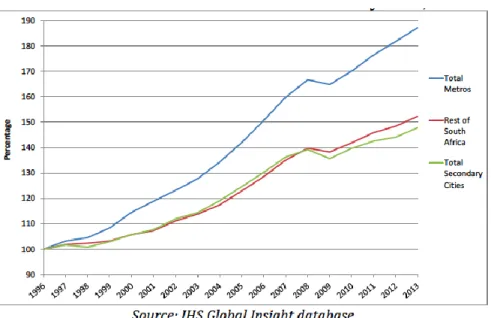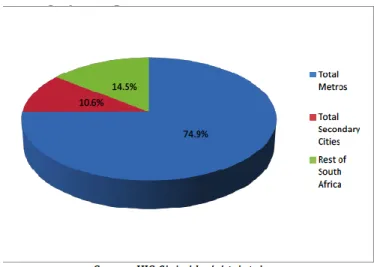This led to the enactment of the Spatial Planning and Land Use Act (SPLUMA) of 2013. Two of the nine policy levers identified by the Integral Urban Development Framework (IUDF) relate directly to the scope of this report: integrated urban planning and management (policy lever 1) and efficient land management and management (policy lever 5).
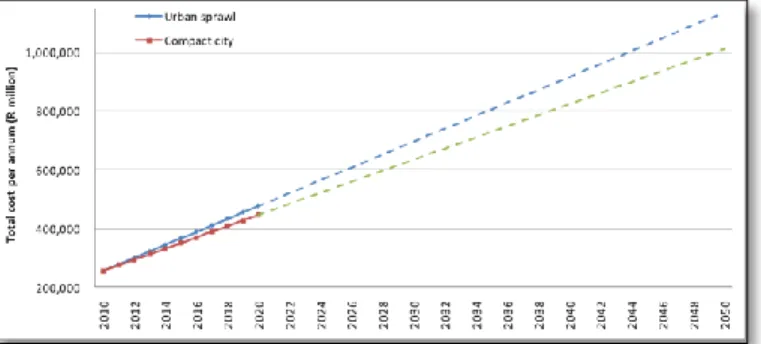
5 Confronting the urban crisis: an urgent challenge
Each of the aspects described by the central black blocks must work to achieve the desired results; The complexity of the urban planning process - and the range of variables represented in the black blocks - requires careful execution of each step in the process.
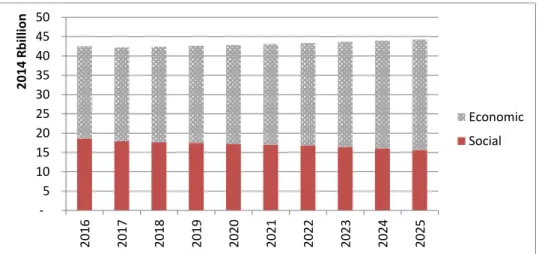
6 Reflecting on past confidence in urban plans
In the first decade of the twenty-first century, integrated development planning was rolled out in municipalities across the country. 5 of 2009, both required integrated transport plans to be developed as part of the IDP planning process.
7 Recognising the limits of post-apartheid planning frameworks
National departments gradually added to the requirements of the IDP, stipulating in the sectoral legislation that focused sector plans must be drawn up and implemented as part of the IDP process. The IDP was increasingly recognized internationally as good practice in urban planning; in the 2004/2005 State of World Cities Report, South Africa's promotion of IDPs was praised as “the clearest manifestation of the new urban planning culture”, a sign that planning in that country was becoming more strategic, participatory and integrated.”13 Recognizing the shortcomings of the IDP, the primary urban planning instrument at the time, a supplementary requirement was introduced in the form of the Built Environment Performance Plan (BEPP).
The BEPP was not intended to replace the IDP, or any part of the IDP.
8 Planning law reform: legal distractions
And it also reaffirmed cities' executive decision-making authority over municipal planning, allowing them to approve plans and land use applications. In the most recent case, Tronox KZN Sands (Pty) Ltd v Kwazulu-Natal Planning and Development Appeal Tribunal and others,16 the judge stressed “the inviolability of the executive municipal power and the need to interpret the Constitution in a way that respects that power.”17 He also explained that the authority of local government to manage municipal planning is “autonomous and cannot be impaired under any circumstances.”18. The National Department of Rural Development and Land Reform (DRDLR) announced that SPLUMA would be implemented on July 1, 2015, and supported initiatives in most provinces to develop provincial legislation and municipal ordinances to complement SPLUMA.
While the new law raises a number of practical questions about how it will be implemented in practice, it ends years of speculation about what kind of spatial planning and land use will finally be adopted.
9 Current issues: what do we need to address?
Overlapping legal requirements
For example, SPLUMA introduces the requirement of a municipal framework for spatial development (MSFD), as part of the IOP that is required under the Municipal Systems Act. Due to frustration with the poor spatial (and other) results of the IDP-based municipal planning system, the BEPPs were introduced. A unique aspect of the BEPP is that the legal mandate to create the plan is renewed annually, with the enactment of each fiscal year's Division of Revenue Act.
This flexibility is further enhanced by the National Treasury's authority to prescribe detailed, annual BEPP guidelines for subways.
Institutional arrangements for city planning
- Divergent policy intentions of national and city governments
- Crowded national departmental space
- Internal integration at a municipal level
- Uncertain role for provinces
- Urban planning as a mandate of the Department of Rural Development For historical reasons, the mandate for spatial-planning legislation, irrespective
An important intervention in this struggle was the adoption of the National Development Plan (NDP) in 2013. The National Development Plan 2030: Our Future, 2012 assumes a central role for the Department of Performance Monitoring and Evaluation (now the Department of Planning, Monitoring and Evaluation) in ensuring the implementation of the NDP. Under the constitution, the provinces have the power to legislate in the area of provincial planning.
The Department is responsible for leading and supporting the implementation of the Spatial Planning and Land Use Management Act of 2013, in accordance with the policy commitments made by the national cabinet in the 2001 White Paper on Spatial Planning and Land Use Management.
Infrastructure investment planning
- Infrastructure-investment planning split over multiple instruments
- Misaligned city-making sectoral grants: housing and public transport
Performance Plan, the Department intends to use its mandate for spatial planning in the following way: "The department is the de facto national land administrator and spatial planner. The Department's Strategic Objective 2, as reflected in the 2015/16 Annual Performance Plan, goes even further and emphasizes the need to focus on improving land administration for rural areas. The misalignment of allocations for housing and public transport infrastructure is widely recognized as a key factor in the perpetuation of low-density, inefficient and segregated urban development.
Similarly, the city, which since 2010 has had a clear mandate to implement municipal planning, should be able to use its IDP process to integrate the two funding streams and the two project planning processes in the housing and transport sectors to achieve spatial change "on the ground".
A theoretical basis or model for city planning
- Finding a post-apartheid spatial model for our cities
- Exploring new approaches to city-planning methods
Second, this understanding of the plan as a static guide to future decision-making strips the planning process of the flexibility that is inevitably needed in the dynamic context of fast-growing cities. The planning environment for cities is one of relatively low predictability, however, especially in terms of the availability of financial resources for implementation. However, these shortcomings of the rational belief system that necessarily supports the municipal planning approach are largely unavoidable.
Each of the planning approaches identified in the NBS review can guide the identification of an approach that better suits the needs of South African cities.
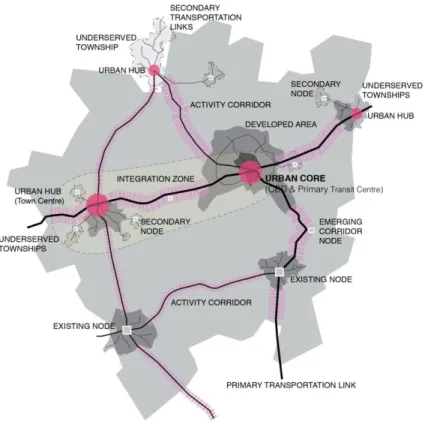
Linking planning to implementation
- Planning and land-use management
- Planning and budgets
- Planning and public land
- Planning and financial performance
This will lead to greater uncertainty, not less, and will make linking planning and land use management more difficult. The way a metro operates its land use management system has a direct impact on its ability to influence and guide the private sector's investment decisions. When a land use management scheme over-provides use and development rights over a wide area, it is unlikely that the metro will achieve targeted investment in the identified areas or zones.
Introducing change and innovation in the land use sector is technically and legally challenging for the municipalities.
10 Recommended actions: the way forward
Alignment with NDP and IUDF
Cities’ planning-alignment action steps
One city, one plan: a single, aligned spatial planning framework combined with a capital investment framework for one city, respected by both other spheres of government. Clarify national government mandates and powers in urban planning: Identify principles and norms for aligning national investment priorities in urban development and confirm the range of realistically possible interventions for assigning and confirming oversight, policy direction, regulation, monitoring and support for urban planning among national departments. Affirm the mandates and powers of provincial governments with regard to urban planning: Identify the role provincial governments must play in aligning investments in various sectors of provincial powers, such as education, health and housing, with urban planning objectives; identify the role of provinces in regulating urban planning as well as provide monitoring and support.
Streamline municipal roles in urban spatial planning and management: eliminate duplication and overlapping of functions in metros, develop a model for city-wide coordination of spatial and investment planning, integrate funding streams for public transport and housing expenditure, align compliance requirements for IDP (Utility Systems Act) and BEPP (DoRA), and clarify the respective roles of cities, other spheres and parastatals in the development of public land for spatial transformation.
Mandate to drive the initiative
The broad steps outlined above are to be reflected in a report to Cabinet to be submitted within a few months. It would make sense for this report to be submitted as part of the Department of Cooperative Governance's report to Cabinet on progress on IUDF implementation. This report must be accompanied by a detailed strategy indicating the main steps to be taken over the next five years, identifying which actions will lead to which results, and clearly outlining the respective responsibilities of each of the relevant national departments as well as each sphere of local government.
This strategy will then serve as the basis for the design of comprehensive action programs to be implemented across all three spheres.
11 Appendix 1: The legal requirements for city planning
The IDP
- Legislative basis
- Purpose of the IDP
- Relationship to other planning requirements
- Link to municipal budget
- Legal effect
- Public-participation requirements
A complex challenge for the IDP therefore already emerges in the legislation: in terms of article 25 it must. Among the core components of the IDP listed in section 26, it is specified that there is a The spatial development framework that must form part of the IDP must also, in terms of IDP regulations, include "a capital investment framework for the municipality's development programs" (regulation 2[4][e]).
The Systems Act's orders regarding the role of the IDP in relation to the budget are reinforced in the MFMA.
The MSDF .1 Legislative basis
- Purpose of the MSDF
- Relationship to other planning requirements
- Link to municipal budget
- Legal effect
- Public-participation requirements
The IDP "binds the municipality in the exercise of its executive powers, except to the extent that there is any inconsistency between a municipality's IDP and state or provincial law, in which case such law shall prevail". The IDP regulations do not add much to the requirements of the Act, except Regulation 3, which prescribes a procedure for IDP change. The main link to other planning requirements is the direct reference to the SDF, which is part of the IDP.
In this case, the law requires that the conflict be resolved through the provisions of the framework law on intergovernmental relations with a view to possible
The BEPP
- Legislative basis
- Purpose of the BEPP
- Relationship to other planning requirements
- Link to municipal budget
- Legal effect
- Public-participation requirements
Section 21(n) of SPLUMA includes as part of the MSDF a "capital expenditure framework for the municipality's development programmes, mapped out spatially". The 2016/2017 BEPP guidelines suggest on page 3 that “the BEPP is intended to contribute to and improve existing statutory planning instruments and. Section 14(4) of the 2015 DORA requires the city to “report in its annual financial statements on the expenditure of each of the said grants.
This requirement underlies the importance of a very close connection between the provisions of the BEPP and the municipal budget.
